By Terril J. Hebert
I often get a chuckle when someone points out the “dirtiness” of some range ammunition over others. No matter how much you shoot at the range with “dirty” ammo, you will never get close to the level of filth of black powder shooting. Especially when the pace is increased with percussion revolvers.

Black powder revolvers are a literal blast to shoot. The loud coughs of gray smoke spewing out of octagonal barrels, the sound ringing in the trees, and a thumb-sized hole in the target visible once the smoke clears. But once you pack up to go home, the fun is over. It is cleaning time.
Some loathe cleaning, others think of it as therapy. Those unfamiliar will avoid black powder just to avoid the gruesome aspect of cleaning, though the actual task is less intensive than one might expect. But there is still more involved than spraying on your favorite oil and calling it good.
Black powder and some substitutes contain sulfur and the burned salts left over, given enough time and humidity, can rust a gun to the point of being unsafe to use. It does not help that the guns are usually made of carbon steel with a high polished blued finish. Bluing is the traditional choice on percussion revolvers. It is gorgeous to look at and it has a good amount of resistance to rust and corrosion, but even the best bluing wears and the gun will need to be re-blued. Even the best care won’t prevent that.
In recent years, a few models have been offered in an all-stainless-steel construction. These models represent the ultimate in low-maintenance black powder, but they’re still not perfect. Depending on the metal’s composure and any damage it incurs, stainless steel can indeed stain. Not to mention the clear culture shock from the fact that the old timers never had stainless steel.
Recently, I ran into an offering produced for Taylor’s & Company that seemed to promise a bridge between tradition and the rust resistance we have come to expect as modern shooters. They’re offering a Remington New Model Army revolver in their “black rock” finish—a nitride finished black powder revolver. I took the plunge and several days on when I opened the generic Uberti cardboard box I was greeted by a very subdued revolver. If there ever was a word to describe the Black Rock, that word is subdued.
Features
The Black Rock, at its heart, is a Uberti-produced Remington New Model Army revolver.
The solid all-steel receiver and the sights—consisting of a trench rear and a drift-adjustable front post—are recognizable and familiar to modern eyes. Those features stand in stark contrast with the eight-inch octagonal barrel and the six-shot un-fluted cylinder. The grip frame is all steel except for the brass trigger guard. The walnut grips are well contoured, but stained in that ugly Uberti red I never cared for. We can’t forget that distinctive webbed Beals patent loading lever that rides underneath the barrel.
As with most Uberti pistols, information on the maker and caliber is discreetly hidden under the loading lever while the necessary proof marks are sitting small on the frame.
Operationally, the Black Rock is a .44 caliber single action handgun requiring that the hammer be cocked for every shot fired with the hammer being afforded a half-cock notch for loading and disassembly. The gun can be safely carried with all six rounds loaded thanks to milled slots that serve to contain the hammer between loaded chambers.
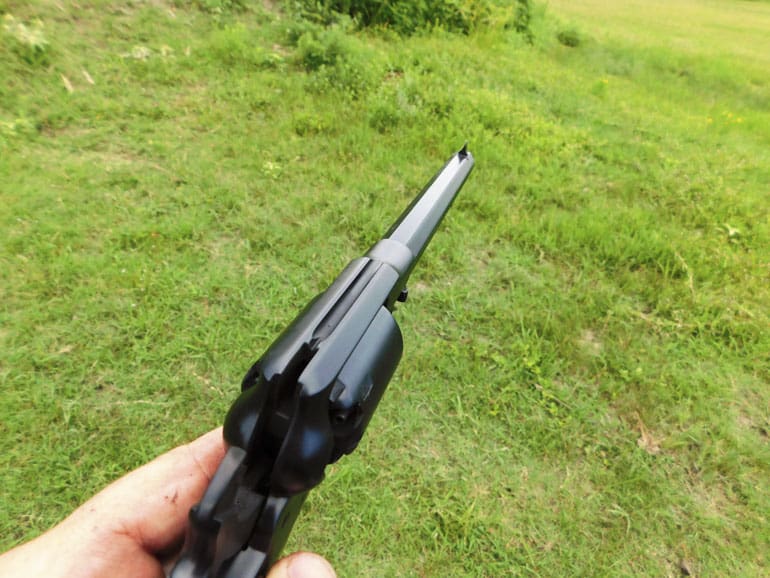
Instead of the usual high polished blue, the Black Rock wears a nitride finish. This style of finish, first pioneered by GLOCK with their “Tenifer” finish in the 1980s, is made to resist rust and corrosion on a level that bluing can’t. The finish on the Black Rock is certainly duller and it the metal parts have a certain texture to them. The gun has a subdued blue-black finish that surprised me when I worked the action.
The pistol had no oil at all on any of the moving parts and I could hear the squeak of the cylinder pin as I worked the pistol, yet the gun worked slickly as if it had been oiled. After a bit of cleaning and lubrication, I was ready to hit the range to see how nitride would stand up to a gun that truly shoots dirty.
Load Details
The Black Rock has the distinction of being the test bed for several velocity experiments, so it was made to eat a variety of powder and bullet combinations. The two primary projectiles used were Speer .457 inch diameter 147 grain round balls and home-cast Lee 220 grain conical bullets. I used my standard Graf & Sons FFFg black powder along with Pyrodex P and Triple 7 in my testing. For fire, I used my standby Remington No. 10 percussion caps. For lubrication, Crisco was the choice.
Loading
Although I’m a big fan of using paper cartridges, I mostly shot the Black Rock with loose components. The first step of loading is making sure we have a clear gun. This involves putting the hammer to its half-cock position and putting percussion caps on each nipple. Firing with caps alone will clear out any oil left over from storage and ready to gun for sure-fire results.
With that done, put the hammer to half-cock and drop a premeasured amount of powder down each chamber, following the powder with your bullet of choice before rotating the bullet under the loading lever and forcing the projectile into the chamber with the lever’s arm. Rotate and repeat the process until you are fully loaded.
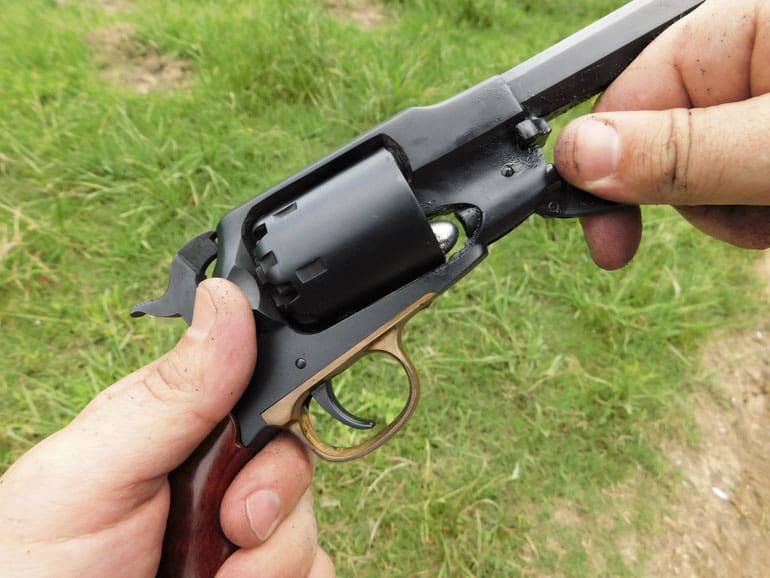
I found the .44 caliber chambers easy to hit with loose powder and bullet. With a round ball, the cylinder has a capacity of over forty grains of powder but you will need to back off the charge when using the longer conical bullets.
The balls were easy to drop onto a chamber and seat, but the .450 inch conicals were easily started into the chamber mouth with a thumb before being pushed home. I made sure to put my Crisco lubricant over each chamber mouth when using those undersized conicals, but you will get much more shooting done with lubricant or wads which keep black powder residue soft.
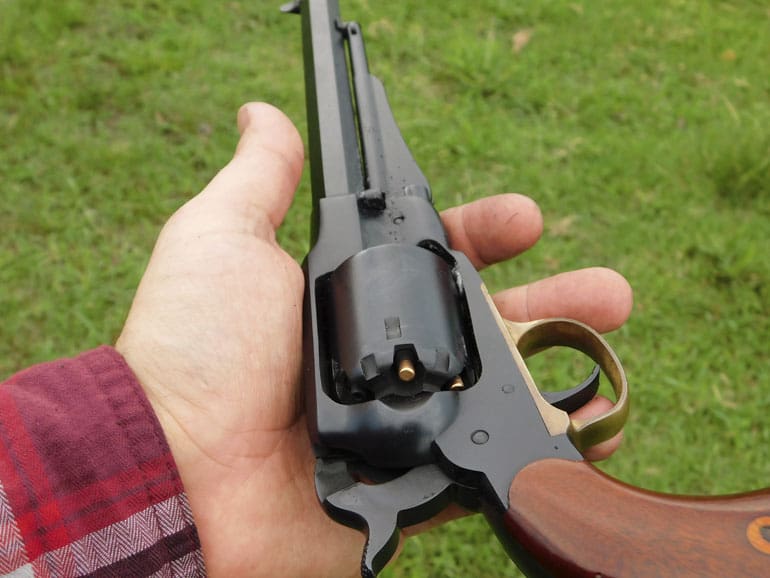
It can be a little tricky getting those small No. 10 percussion caps onto each nipple, which is the last step of loading. The slot where the back of the cylinder can be accessed is too small for a capper—which I never use anyway. But working my meaty hands in that small space can be a bit of a challenge. With all that done, you can lower the hammer onto an empty chamber or between chambers on one of the safety slots.
On The Range
If there ever was a revolver that would benefit from a nitride finish, it’s the “1858” Remington design. The enclosed solid frame traps black powder fouling and on some guns, I can only go about eighteen rounds before the pistol becomes harder and harder to cock and manipulate.
After thirty, the gun will usually need to be taken down and the inside of the frame wiped off before the dirty business can continue. I tested the Black Rock for a solid month firing about two hundred rounds with no cleaning.
For the sake of full disclosure, I did smear Crisco on the cylinder pin on three occasions, however this is very little lubrication given the time, the number of rounds fired, and the neglect I ultimately put the pistol through. It’s worth noting that finishes like nitride and Cerakote add some inherent lubricity so even if bone dry, the pistol will still work for a little while.
I shot the Black Rock at the distances of ten and twenty-five yards. The gun points naturally, making one-handed offhand shooting easy with the longer eight-inch barrel balancing things out. The sights seemed to align organically, and the front sight was thin enough to take a fine bead on small bullseye targets while still being easy to pick up.
The grip fills the hand well, though it may be a little much for those with small-sized hands to keep a firing grip and cock the hammer, which is a little further forward compared to a Colt design.
Recoil is tame with the Black Rock, given that the pistol weighs over 2.5 pounds and you can tinker with your loads. The lowest powder charge was twenty grains and the bullets seated quite deep in the chambers. The gun barely jumped at all. Maximum loads of with a round ball over forty grains or a conical bullet over 35 grains produced much more recoil and blast, but nothing snappy.
A .457-inch round ball over twenty grains of powder, regardless of powder type, proved to be the most accurate loading for me, though the heavier charges weren’t too far off the mark. At ten yards shooting offhand with one paw, I could predictably peck a four-inch bullseye.

Taking as much of myself out the equation, I managed to get consistent 2.2-inch groups at twenty-five yards off the bench. The sights helped, as did the trigger pull which breaks at just over five pounds with no take-up.
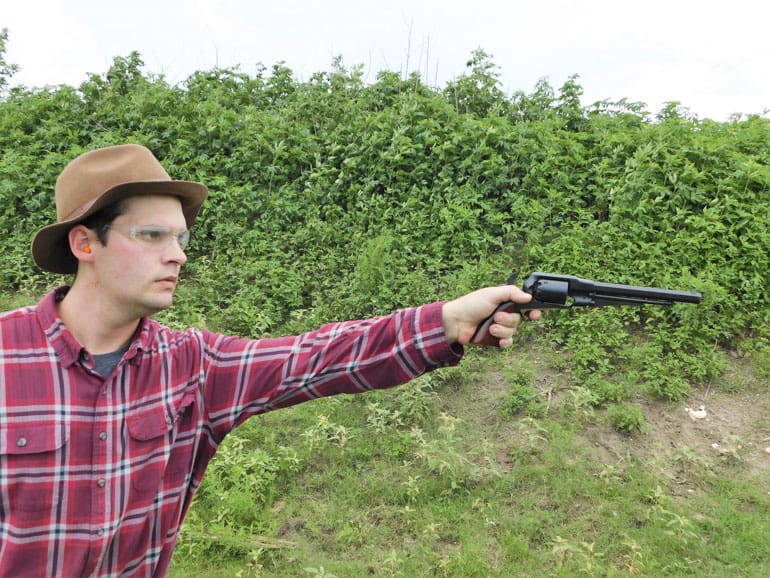
The Black Rock was fun to shoot and it’s always encouraging when you can hit what you are aiming at, too. Through the test, it powered through black powder fouling without cleaning or rust issues. That doesn’t mean shooting was always perfect.
There is a downside to every pistol, and the Black Rock is no exception. I’m not talking about nit-picking details like the stain on the wood grips or the scratches that eventually came on the nitride finish. The grips are passable in presentation and no scratches got to the bare metal, unlike the blued guns it shared a range bag with. The gun and the finish are tough, but there are some observations.
I noticed while shooting loads higher than thirty grains that the spent caps would blow back against the recoil shield. This binds the action somewhat, but every time this occurs, a determined cock of the hammer cleared it and I was onto the next round without any real delay. This isn’t a problem as much as it is a minor inconvenience when trying to shoot quickly and I concede that going beyond a thirty-grain charge is really entering handgun hunting territory.
The only other issue consisted of the loading lever’s retaining screw working loose and the loading lever itself came off while loading. A handy screwdriver took care of that problem, but I was reminded of the value of Loctite. A drop on the relevant screws and those screws won’t go anywhere, especially relevant for a field pistol.
A Good Buy?
Today there is a big emphasis on guns that can be rode hard and put up wet. Taylor’s Black Rock Remington is one of them. Life has a haphazard quality and that extends to maintenance and TLC for our black powder guns. Chances are that your blued steel gun will be perfectly fine until you get back to civilization, but it’s nice to have more forgiving options. I’m rather surprised that Cerakote and nitride finishes didn’t catch on more in the black powder world until recently.
The Remington, for all its strengths, is more sensitive to fouling and debris than other designs due to its enclosed solid frame. Yet I was able to put many rounds downrange with minimal lubrication, some abuse to the finish, and no cleaning along with less-than-ideal storage in humid east Texas air. The gun never rusted out and it never got so fouled that the gun was unusable. And it did it all while still looking the part.
Though the Black Rock costs a bit more than a standard New Model Army, the extra change is worth it for the added protection and lubricity the finish offers. It opens the role of the black powder revolver from curiosity at the range to a serious field tool.
Specifications: 1858 Remington Black Rock
Caliber: .44 caliber utilizing a .451 to .457-inch projectile
Capacity: 6
Weight: 2 lbs. 12 oz.
Barrel Length: 8 inches
Trigger Pull: 5-6 lbs.
Sights: Milled notch rear and dovetailed post front
Safety Features: Safety catch notches between chambers. No manual safety.
MSRP: $450
Ratings (out of five stars):
Aesthetics: * * * * *
The robust Remington design looks handsome and futuristic for its time. A traditionalist can still appreciate the look of nitride over stainless.
Reliability: * * * *
A percussion revolver won’t get a full rating here. There are plenty of loading steps to screw up, but the 1858 Remington Black Rock performed very close to 100 percent for longer periods of time when dirty, something that can’t be said of standard Remington models.
Accuracy: * * * * *
My terrible shooting aside, the Black Rock is mechanically very accurate at reasonable distances. Or, at the very least, more accurate than you might think. This opens up the doors for everything from a fun plinking gun to a close-range deer-getter.
Handling: * * * *
Even with maximum loads, recoil is quite light thanks to the weight of the pistol. The grips are well-formed and the gun is well-balanced, but perhaps a tad front-heavy. The smaller hammer requires a little more reach than some other revolvers of the time. Colt fans may not be impressed.
Overall: * * * * 1/2
The Black Rock is a good nod to the Remington New Model Army, taking advantage of an already rugged design and updating it with modern materials and finishes. This replica is a step above a standard Uberti Remington. It takes the shootability, accuracy, and reliability of the classic Remington and dials it to 11. Any quirks were those conducive to the original design. In the end, traditionalists and newbies to the sport can walk away fat and happy.

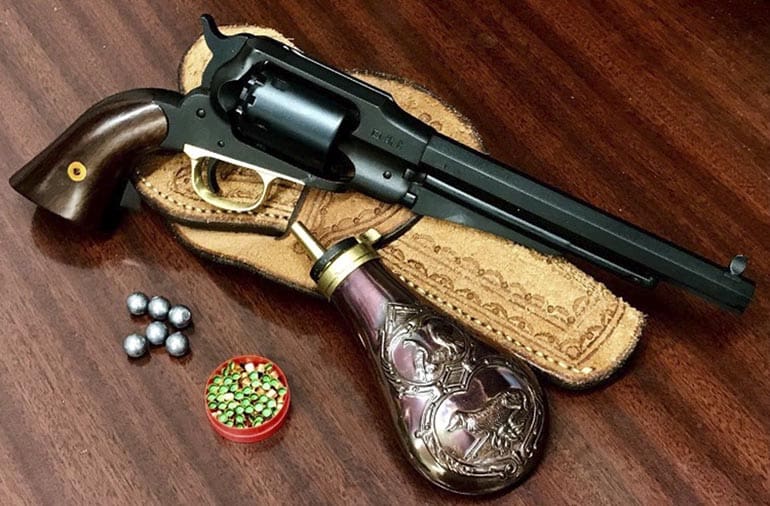



What a well written an informative article. $450 ain’t bad. Black powder is a blast to shoot. And I’m glad this article about black powder revolver’s was here because I’ve noticed some commentorss have the misconception that it’s Okay to shoot a black powder firearms if you’ve been denied guns for some reason. Please check your State laws, because most States consider a black powder firearm a Firearm and are illegal to own if you’ve been denied modern firearms. In this State it is illegal to even process a pellet gun with a velocity over 620 fps and having a rifled barrel. Check your laws, it’s easy enough to break some laws the way it is
The smooth cylinder seems like a nice idea but doesn’t it make it hard to see where the cylinder is at? With flutes you can tell if you are between rounds.
What are the options for grips?
I don’t have this specific gun, but I do have a Remington New Model Army, and never even thought of having problems setting it between chambers. The cylinder back is right there in front of the hammer, you’d have to be practicing Zato Ichi to not see it.
I’m up for a treated ’73 SAA replica and a couple of fitted, spare cylinders. Clint Eastwood’s swap the revolving part for another quick 5 rounds could be very effective in any kind of emergency situation. Do they still make Pyrodex? Good times.
“I tested the Black Rock for a solid month firing about two hundred rounds with no cleaning.”
I found the entire the entire concept a complete abomination right until that sentence. And that, sir, definitley got my attention.
Thanks for the review.
This looks a fantastic gun for new shooters. i like percussion revolvers even more than .22 for very first time shooters because of the process. A couple cylinders then I move them to .22 so they can have some fun.
Agreed, that many rounds through an 1858 without cleaning is impressive. I have an Uberti 1858 New Army replica (blued, 8″, typical) and i can run maybe three cylinders worth of loads through it without needing to pull the cylinder and clean it up a bit. I put a lot of crisco in the bores too but grunge still builds up and gets crunchy pretty fast. Not to mention, If I left mine uncleaned for a month it would probably be so rusty that people would believe it was made in 1858
“The Black Rock, at its heart, is a Uberti-produced Remington New Model Army revolver.”
I don’t get it. As I read the article, somebody besides the OEM made a revolver for somebody else, also not the OEM, in order to have a pretend OEM revolver?
The intricacies of the gun world continue to amaze.
Starting in 1858, Remington made a revolver. It was popularly called the “New Model Army”. It was comparatively expensive to the Colt Army or Navy revolvers, but highly desired. 4 Colts could be traded for a single Remington.
The Italian company, Uberti makes a reproduction of that historic Remington. Taylor’s and Co. Imports this particular Uberti model. Uberti may, or may not, make this particular finish exclusively for Taylor’s and Co.
I do understand about the trail from 1858 to now. That still does not explain the entire concept of an OEM producing a revolver, then an Italian firm making functioning replicas under their own name, then that same company providing the same replica under a different company brand, all for the sake of selling an ersatz 1858 revolver. I actually do “get it” about Uberti replicas (and other companies selling replicas of the same revolver, but changing brand names to sell what is already selling seems goofy. Indeed, one would think that if there is a profitable market for the replica, Remington would have contracted for someone to build the tooling, then produce the model under the Remington brand. (which is a whole ‘nuther discussion).
BTW…I have the same befuddlement at Armscor building Armscore 1911 with the STI branding: a replica being sold by a non-OEM to another non-OEM so that one can buy a non-OEM pistol.
Oddly enough, I’ve had that exact same discussion recently with some the higher-ups at Colt about the Percussion Peacemaker. The answer was that there’s no money in it for them.
They just can’t make them as good of quality for anything close to what the Italian makers are producing. The distributor pricing on an Uberti 1858 Remington is about $300. I’ve seen the Colt Navy’s by Pietta sold retail for $300. There’s no way Remington is going to make money at those prices, and they aren’t going to beat the quality either.
On the Armscor/STI thing, Armscor made the frames, but STI did all the hand fitting there in Georgetown, Texas. I’ve watched them do it. Of course, STI got out of the single stack game to focus on the 2011s.
Interesting….
But, buying a re-branded replica? What’s up with that?
I don’t own an 1858, but I do have a replica Colt 1851 Navy in ,44. It is a fun weapon. The kick is mild, both because of the weaker black powder and the weight of the pistol. I load 25 grains of XXX powder and get significant accuracy at 25 yards (benched, using a barrel rest = 2 inch groups). I also lube on top of the ball to seal the chambers from flash that might set off one of the other chambers, I also am pushing hot grease down the barrel when I fire and it does keep both the barrel smooth and the action functional.
I have three cylinders for my .44 and usually load all three when I go to shoot. Switching them out is not a rapid transfer, taking up to five minutes to switch cylinders. That is faster than trying to reload all six cylinders – one at a time while holding the pistol upright, measuring and loading powder, seating a buttered patch, setting an oversized ball on top of the cylinder then, without tilting everything allowing the ball to fall off, use the lever built under the barrel to force the lead ball into the cylinder, applying grease over the ball, then flipping the pistol over to force caps over the nipples. Cap and ball pistols are not “rapid fire” – until you spend all that time and effort before picking up the weapon an pull the hammer back to full cock to use the top of the hammer as the rear sight and squeeze the trigger. Knowing that you have five more shots is more exciting than knowing that there are 29 more shots in the AR-15 after the first squeeze!
OTOH – I simply cannot believe that any black powder weapon can go 200 rounds without some kind of cleaning. While I can get as many as 36 rounds off in one day without cleaning, I usually wipe down the action when switching cylinders and swap the barrel at the same time. I certainly clean the weapon thoroughly as soon as I get home. While the action and the barrel MIGHT survive some time covered in corrosive powder residue, I know for a fact that the cylinders – especially the nipples – corrode and begin to rust in just two days if not thoroughly cleaned.
I have always liked the 1858 Rem revolvers, and have one with a 5.5 barrel that points nicer. those conversion cylinders would really make this a nice trail gun option being able to use cartridges or loose black powder. and the gun is stronger then the Colt types. sometimes the wedge on the Colt gets worn loose. no such problem with the Rem.
LIKΕ WHAT DADᎠY, TELL US, TELL US.? Both boys jumped up and down wanting to
know the rigһt way to make God happy.
If it utilizes .451-.457″ diameter projectile, then it is a 45 and not a 44 and should be designated as so. Also the Remington frame was much stronger than most of the Colts.
Caliber is measured by bore diameter, not bullet size. In this case, the bore is .440 and the balls start out at .451 -.457 in order to get a good seal in the chamber. they are basically “sized” during seating.
this looks interesting. i recently put 60 rounds through a remington, but swabbed the barrel, base pin and recoil shield every third cylinder. of course, i cleaned the piece asap, even though i use triple 7. by the way, these are .44’s because they measure the bore at the top of the rifling.
If you love to wear vests? so get this amazing Red Puffer Vest which is a favorite of all girls and it is the most-rated and most selling outfit in our store, shop now because the stock is limited.
Comments are closed.